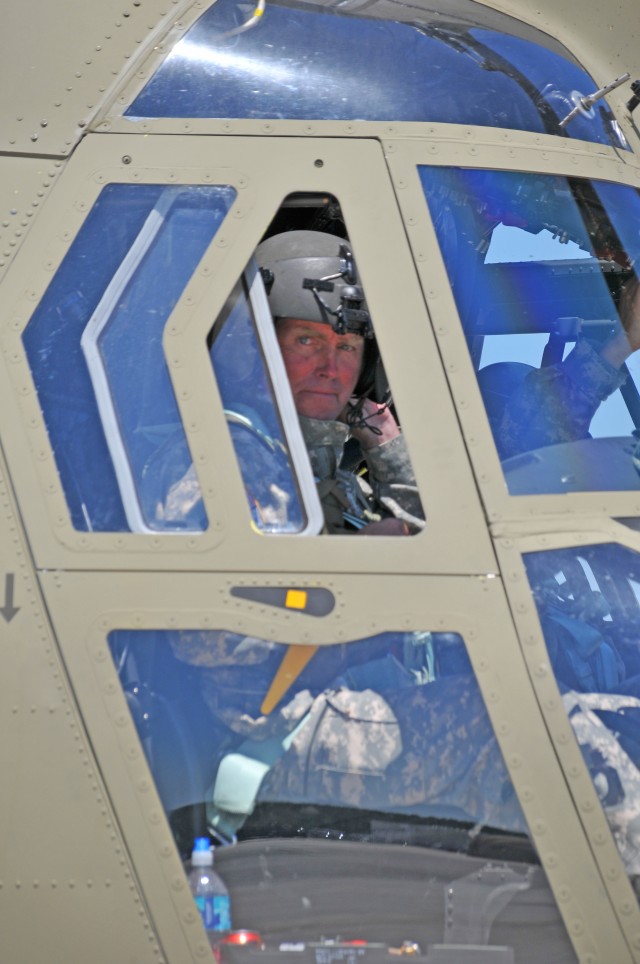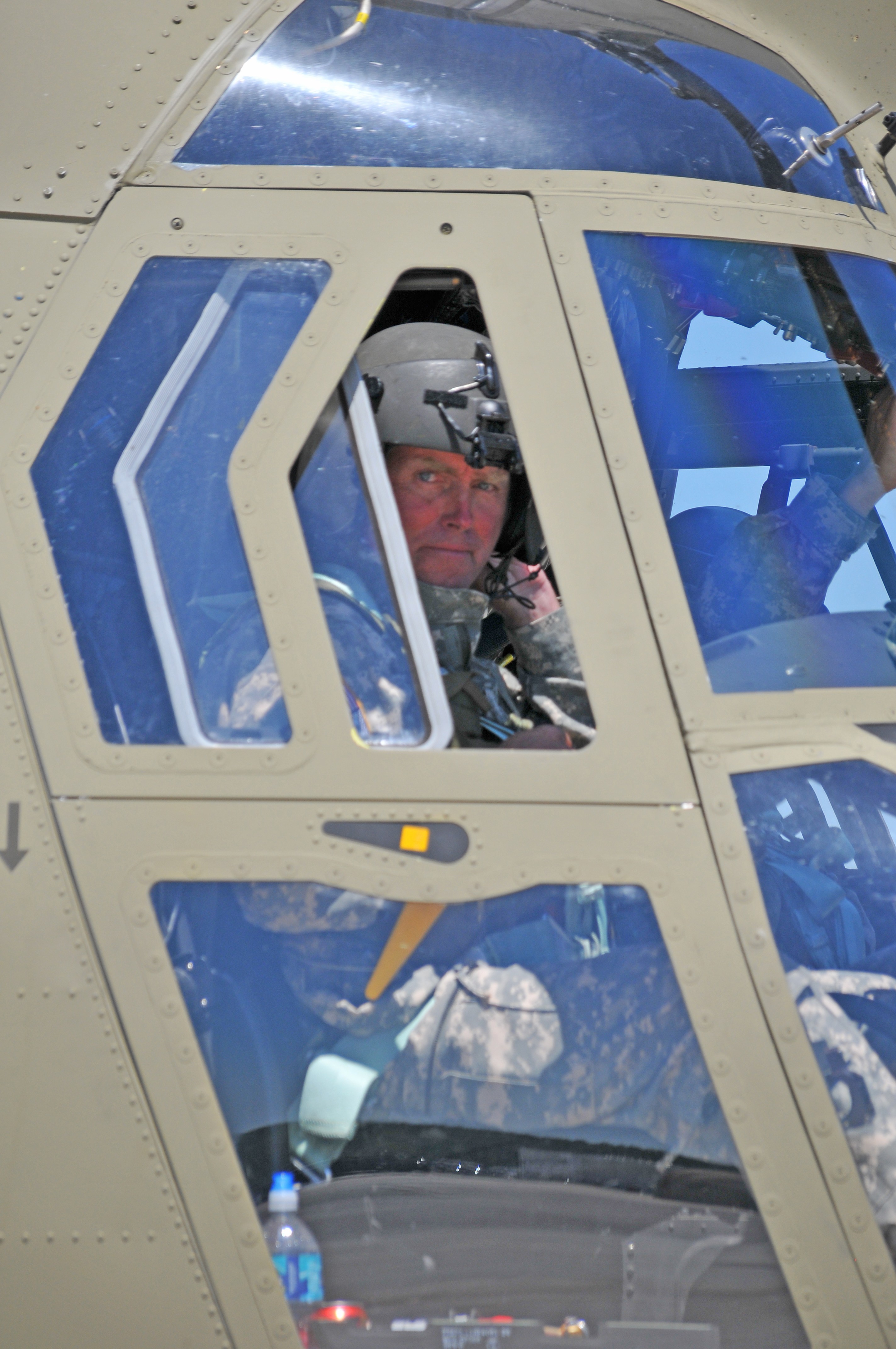
REDSTONE ARSENAL, Ala. -- During his early years as an Army helicopter pilot, Kiowas, Cobras and Apaches were Col. Newman Shufflebarger's aircraft of choice.
But when the Army called for him to take over as a Chinook product manager, his affinity for the attack helicopters soon took a nose dive.
It wasn't that he didn't still admire the capabilities of the Army's attack helicopters. Rather, it was a growing appreciation of the power and might of the Chinook that stole this pilot's heart.
"I grew up flying Kiowas, Cobras and Apaches. That was my background on the tactical side," said Shufflebarger, who received a Bronze Star for his contributions as an Apache helicopter pilot during Operation Desert Shield/Storm.
"I was selected as a product manager about halfway through my career and I had to take an assignment that basically fit the needs of the Army. I was selected for the Chinook - CH-47F - prototype development. It was the best thing that ever happened to me because the Chinook is an awesome aircraft. There is no other aircraft as versatile as the Chinook. It is used for disaster relief and humanitarian assistance as well as combat and service support. It is even hitting on the fringes of Special Operations with its precise navigation system that always keeps it on time and on target."
The colonel praised the Chinook's heavy-lift design and its tandem rotor, which allows for 100 percent power and 100 percent lift for every mission, and a top speed of nearly 200 mph. It is one of the few aircraft from the Vietnam era that is still in production and used on the front lines of today's battlefield. More than 1,180 Chinooks have been built to fulfill the Army's needs for troop movement, artillery emplacement and battlefield resupply.
"It's the Army's fastest aircraft with a long history," he said. "We had Chinook A, B and C models in Vietnam. We had the Super C model during the Cold War. The '80s brought the D model and the '90s brought the conversion of all Chinooks to the D model. Now we have the D and F models. And with every new model the amount of payload has increased. We've gone from 30,000 pounds to 50,000 pounds in the evolution."
Shufflebarger serves as the project manager for Cargo Helicopters (Chinook) for the Program Executive Office for Aviation, a position that involves managing a fleet consisting primarily of CH-47 D and F models. He will said goodbye to his 26-year Army career on May 19 during a retirement and change of command ceremony at Redstone Arsenal's Sparkman Center, Bob Jones Auditorium. Brig. Gen. Tim Crosby, the program executive officer for aviation, will preside.
It was actually his first assignment with the CH-47 F in 2000 that brought Shufflebarger to Redstone. During that three-year assignment he managed the Army's newest lift aircraft through the production of two engineering and manufacturing development aircraft, conducted a successful flight test program with more than 150 incident-free hours and gained Army approval to enter production in 2002.
In 2006, after graduation from the War College and an assignment in the Pentagon as the military assistant to the undersecretary of defense acquisition, technology and logistics, Shufflebarger returned to Redstone, where he became involved with the production, training, equipping and sustainment of the same CH-47 F model that he had brought into production during his first Chinook assignment at Redstone. As the project manager for Cargo Helicopters, Shufflebarger oversees the work of nearly 400 employees in the life cycle management of the Army's entire Chinook fleet, including all CH-47 D and CH-47 F models.
"Anything that deals with the Chinook and its entire life cycle management goes through this office," Shufflebarger said. "Every entity with the Aviation and Missile Command that deals with the Chinook is co-located here with us, including acquisition, logistics, foreign military sales and air worthiness. Any parts, any help or assistance requested, any deployment of Chinooks - that's all part of us."
His current assignment allowed Shufflebarger to oversee the fielding of the F models.
"We actually had the first F model in November 2006. We took it through developmental and operational tests, and then went into full-rate production," Shufflebarger said.
"We got permission for a five-year multi-buy of the aircraft so that we could purchase more than 200 during those five years. That saved about a half billion dollars. So far, we've produced and bought 91 aircraft, and trained and equipped six units. Five of those units have already been in Afghanistan and Iraq. Three of those units have returned and one is on future deployment status. This team at Cargo Helicopters has really done great in achieving the mission."
Within those six units, Cargo Helicopters has overseen the training of more than 1,500 pilot and crew members. It has also designed, built and supplied 12 training simulators.
Besides the U.S., 15 other nations have purchased the Chinook. Those aircraft purchases are also managed through Cargo Helicopters.
"Canada bought six and we delivered them during Christmas 2008 in theater to Kandahar, Afghanistan," Shufflebarger said.
Of course, along the way, Shufflebarger did obtain his certification as a Chinook pilot. He uses that training at least once a month, flying a Chinook from the factory in Philadelphia, Pa., to the Madison County Executive Airport, where Chinooks receive post-production equipment, including machine gun mounts, bullet proof packages and aviation survivability equipment. Last year, the Philadelphia plant produced about 1.5 Chinooks per month. That rate is now 2.5 per month and should go up to 3.5 per month next year.
"Flying the F models allows me to check up on the processes and, of course, it allows me to fly an aircraft," said Shufflebarger, admitting he still loves the thrill of flying. "But another reason is, since we are at war, we have no excess of pilots for the F models. With the ramping up of production, we need every pilot we can get."
Shufflebarger remembers falling for a career as an Army pilot as a young boy at Fort Rucker, where his father was a student pilot. His father went on to serve two tours in Vietnam as an Army pilot. Shufflebarger began his Army pilot career after graduating from East Tennessee State University in 1984.
"The Army route was the way to go for me, and after 26 years I couldn't have had more fun," he said. "I've flown six or seven aircraft, and each one has its fun. My career is culminating as the Cargo team lead. My team has made us successful. It's been a privilege to lead this team."
As a captain, he led a team of eight Apaches soon after the Iraqi invasion of Kuwait in 1990, during the first days of Operation Desert Shield/Storm.
"It was assessed to be a tank war, so there was no infrastructure for aircraft," Shufflebarger recalled. "We were the first in and we landed in a desert at 130-140-degrees. It was a very austere environment. I led a team of about 50 Soldiers for almost nine months. First, we were part of Desert Shield in defense of Saudi Arabia and then it turned into an offensive with Desert Storm. We were in the initial assault into Iraq to take out radar sites to make a radar free corridor to allow the Air Force in."
For that mission, Shufflebarger received an Air Medal with Valor Device. He received his Bronze Star for completing the deployment with only one aircraft shot down and no one injured in a war that had a lot of potential to be disastrous.
"At the time, Iraq had the third largest Army in the world. They had chemical and biological weapons. There is speculation they even had nuclear weapon capability," he said.
"In the early stages, there was a lot of high risk. It was a stressful environment. But we were trained and prepared. There was never any scenario when we didn't know what to do. We were the best-equipped Army, and we had confidence in our training and equipment."
Shufflebarger has enjoyed and benefited from every Army assignment.
"It's all been fun. It's really amazing that 26 years have gone by like they have," he said. "Of course, I didn't think that when I was sleeping in the field under the tail boom of an Apache."
In every way, the Army prepared Shufflebarger for the culmination of a long-term career of opportunities and challenges.
"The world-class training in the Army teaches you that you can do anything assigned to you," he said. "As you progress, the jobs have more responsibility. Every new job grows you with responsibility, risk and dealing with different people. Entrusting a pilot with a $35 million (Chinook) helicopter with 38 Soldiers on board will make you grow up fast. It's a great way to serve the nation. You won't find a better team to be a part of. It's an exciting, rewarding and very challenging career profession."
May is not only Shufflebarger's retirement month. It is also time for his son, an Air Force JROTC cadet at Huntsville High School, to graduate and go on to college. That will leave Shufflebarger with his wife, Christine; a Harley Davidson motorcycle; and a desire to go on yet another of life's adventure, only this time a little more grounded. Eventually, a second career in industry - and all the responsibility that entails -- will be on the horizon.

Social Sharing